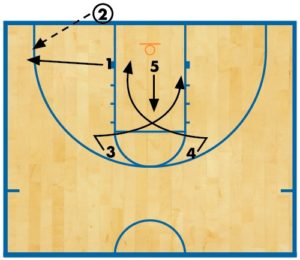‘Over’ man-to-man offense is a versatile scoring machine
The “Over” man offense is a man-to-man offensive package that consists of a series of entries and plays that are designed to be “quick hitters.”
If a shot or score isn’t manufactured by the entry, then all five players in every play will end up in the same group of designated spot-up positions on the floor.
With this offense, secondary fast-break continuity offense easily flows into a continuity offense. The continuity offense can operate for indefinite periods of time, maintaining offensive scoring pressure on the defense, while keeping possession of the ball.
Origin of the ‘over’
The name “Over” originates from the fact that a single player is removed from the basic 1-2-2 box set (we call this the “Twins” set) and that player is placed in the opposite deep corner. This creates an overload of 3 1/2 players on the strong side, and 1 1/2 players on the weak side. Hence the name “Over.”
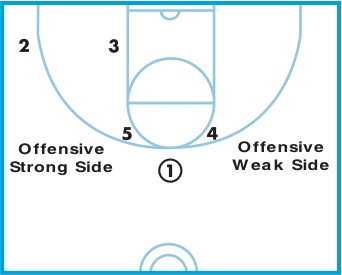
DIAGRAM 1: “Over” set-strong side left. Place two players in the left deep corner, creating the strong side on the left side and the right side becomes the weak side.
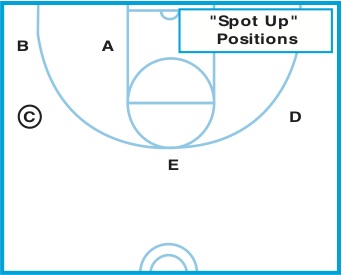 DIAGRAM 2: ‘Spot up’ positions. The spot-up positions are the following:
DIAGRAM 2: ‘Spot up’ positions. The spot-up positions are the following:
A. Ball-side block.
B. Ball-side deep corner.
C. Ball-side wing.
D. Weak-side wing.
E. The point.
Secondary break opportunities
The spot-up positions can easily flow into variations of the North Carolina secondary break.
DIAGRAM 3: North Carolina secondary break variation 1.
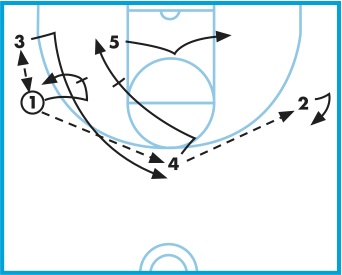 DIAGRAM 4: North
DIAGRAM 4: North
Carolina secondary break variation 2.
 DIAGRAM 5: North
DIAGRAM 5: North
Carolina secondary break variation 3.
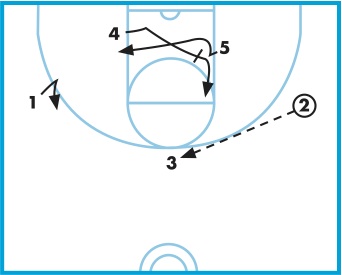 DIAGRAM 6: North Carolina secondary break reversal. After the ball reversal initiates the secondary-break action, the second ball reversal activates the “spin screen” movement between the two post players.
DIAGRAM 6: North Carolina secondary break reversal. After the ball reversal initiates the secondary-break action, the second ball reversal activates the “spin screen” movement between the two post players.
This should result from any of the three options of the secondary break chosen.
Any of the secondary break variations will quickly and smoothly flow into the new five spot-up positions consisting of: a point, one wing on each side, and two low post block positions.
If the secondary break doesn’t produce a good shot or a score, it can smoothly and fluidly flow into a 5-man motion offense, a triangle power offense or any half-court continuity offense you wish to utilize.
Different set, same results
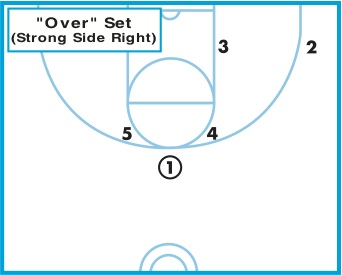 DIAGRAM 7: ‘Over’ set-strong-side right. Coaching staffs should realize that if 4 and 5 exchange positions and if 2 and 3 slide over to the right side, this has changed the original alignment of the “Over” Man Offense to create a new strong side and weak side. If this is done and 3 is kept on the low-post block with 2 remaining in the deep corner, every entry can still utilize the individual’s strengths. The entries and plays are simply mirrored to the opposite side.
DIAGRAM 7: ‘Over’ set-strong-side right. Coaching staffs should realize that if 4 and 5 exchange positions and if 2 and 3 slide over to the right side, this has changed the original alignment of the “Over” Man Offense to create a new strong side and weak side. If this is done and 3 is kept on the low-post block with 2 remaining in the deep corner, every entry can still utilize the individual’s strengths. The entries and plays are simply mirrored to the opposite side.
Entries from ‘Over’
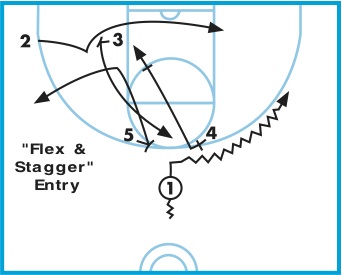 DIAGRAM 8: Flex-and-stagger entry. 1 dribbles to the weak side (right side in this case) off the ball screen set by 4, aiming to reach the free-throw line extended. As this takes place, 3 rubs the defender off the Flex back screen.
DIAGRAM 8: Flex-and-stagger entry. 1 dribbles to the weak side (right side in this case) off the ball screen set by 4, aiming to reach the free-throw line extended. As this takes place, 3 rubs the defender off the Flex back screen.
After the initial ball screen set by 4, both 4 and 5 diagonally go down to set a stagger screen on 3’s defender. The man offensive concept of “pick the picker” is utilized here.
If shots are not manufactured for 1 on the pull-up jump shot, hitting 3 on the Flex cut or with 3 having an open shot at the top of the key off the reversal pass, then the entry has at least provided the offense with a 3-out and 2-in alignment, which can then lend itself to a continuity offense (bypassing the secondary break option).
 DIAGRAM 9: Duck-in entry.
DIAGRAM 9: Duck-in entry.
This play starts with a dribble entry by 1 to the strong side free-throw line extended. 1 scrapes off 5’s screen and immediately looks for 3, who is aggressively ducking into the dotted circle in the exact center of the free-throw lane.
If the defender (X3) plays behind 3, 1 should be able to enter the ball easily inside. If X3 is playing 3 on the high side, either 1 or 2 (in the low and deep corner) should be able to pass the ball to 3 for an easy inside shot.
If X3 is fronting 3, 1 should be able to lob the ball to the corner of the backboard without much worry of help-side defense. This is because 4 has screened X5 at the top of the key (another pick-the-picker action).
5 can scrape off the back screen set by 4 and run a lob route or flare cut to the weak-side wing area. If no good shots develop, the five offensive players are in the spot-up positions to run the secondary-break option that the coaching staff has previously chosen.
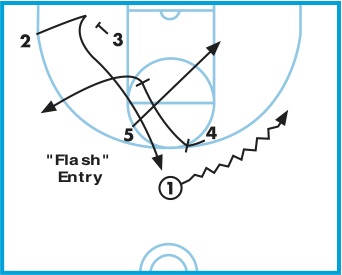 DIAGRAM 10: Flash entry. This is another dribbling entry to the weak side. 1 dribbles off the 4 ball screen, as 5 flashes to the new ball-side, low-post area. 2 sets up the defender as if he or she were to run a Flex cut — but instead runs the defender off 3’s back screen and (if X2 survives that screen) then scrapes off 4’s diagonal down screen to break to the top of the key.
DIAGRAM 10: Flash entry. This is another dribbling entry to the weak side. 1 dribbles off the 4 ball screen, as 5 flashes to the new ball-side, low-post area. 2 sets up the defender as if he or she were to run a Flex cut — but instead runs the defender off 3’s back screen and (if X2 survives that screen) then scrapes off 4’s diagonal down screen to break to the top of the key.
Besides this action giving the offense great perimeter shot opportunities, this three-player game has occupied any help-side defense that could have helped defend the flashing post player on the block, where a two-player game is taking place between 1 and 5.
1 looks to pass the ball away from X5 for 5 to have a great inside shot opportunity. If no inside shot for 5 develops, no jump shot off the dribble for 1 takes place, and no 3-point shot for 3 develops, the offense is immediately able to run the secondary fast break. Again, this puts constant pressure on the opposition’s defensive players.
 DIAGRAM 11: Backscreen entry. 1 dribbles to the free-throw line extended, developing a great passing angle so that he or she may hit 4 on the new ball-side block. If the defense chooses to switch the back screen, this will give your players a “little-on-big” mismatch inside on the block. The only help the defense can provide on the cutting post player is “small player” help (X3).
DIAGRAM 11: Backscreen entry. 1 dribbles to the free-throw line extended, developing a great passing angle so that he or she may hit 4 on the new ball-side block. If the defense chooses to switch the back screen, this will give your players a “little-on-big” mismatch inside on the block. The only help the defense can provide on the cutting post player is “small player” help (X3).
After 5 ball screens 1’s defender, he or she down screens 3’s defender in the paint.
Now 3 becomes the third outside scoring threat (first 1, then 2 and now 3) on more pick-the-picker action. This action forces an isolation play for 4 inside.
2 remains in the deep corner for several reasons. It stretches the defense and prevents X2 from helping out inside. 2 is also either a shooting threat (on the pass from 1) or an inside passing threat to 4 down on the block.
 DIAGRAM 12: Pin-screen entry. If you want to pick on a defensive weakness, for instances of defender X2 being a poor inside defender, or in foul trouble, or utilizing 2’s inside scoring talents, you can simply instruct 1 to come off the ball screen toward the strong side and have him or her dribble to the free-throw line extended.
DIAGRAM 12: Pin-screen entry. If you want to pick on a defensive weakness, for instances of defender X2 being a poor inside defender, or in foul trouble, or utilizing 2’s inside scoring talents, you can simply instruct 1 to come off the ball screen toward the strong side and have him or her dribble to the free-throw line extended.
As this takes place, first 2 “pin” screens 3’s defender, releasing 3 out to the deep corner, while placing 2 down on the new ball-side block.
After the 5 ball screen, 4 screens-the-screener (5’s defender), with 5 using the screen in one of two different manners. If 5 is a good leaper and a strong scorer inside, he or she can run a lob route. If 5 is a good perimeter player who can create, he or she can flare cut to the weak-side free-throw line extended.
If 5 receives the skip pass from 1, that player has the entire opposite side of the court to wheel and deal.
If nothing develops from this action, the offense is in spot-up position to run the secondary break of their choosing or a variety of passing games or motion offenses.


